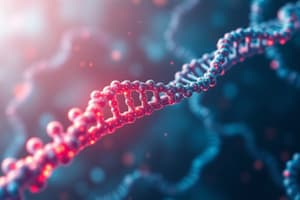Podcast
Questions and Answers
What was one of Frederick Sanger's key contributions to molecular biology?
What was one of Frederick Sanger's key contributions to molecular biology?
- The development of recombinant DNA technology
- The creation of monoclonal antibodies
- The dideoxy method for DNA sequencing (correct)
- The discovery of the double helix structure of DNA
Which year did Frederick Sanger first publish his method for DNA sequencing?
Which year did Frederick Sanger first publish his method for DNA sequencing?
- 1980
- 1977 (correct)
- 1965
- 1955
Frederick Sanger was exempted from military service during World War II due to which of the following reasons?
Frederick Sanger was exempted from military service during World War II due to which of the following reasons?
- Health issues
- His Quaker beliefs (correct)
- His academic commitments
- Government research obligations
What was the focus of Sanger's research after obtaining his PhD?
What was the focus of Sanger's research after obtaining his PhD?
What was the primary achievement for which Sanger received his first Nobel Prize in 1958?
What was the primary achievement for which Sanger received his first Nobel Prize in 1958?
What significant institution did Frederick Sanger establish in 1993?
What significant institution did Frederick Sanger establish in 1993?
Which of the following statements is true about Sanger's contributions to DNA sequencing?
Which of the following statements is true about Sanger's contributions to DNA sequencing?
In what scientific field did Frederick Sanger primarily contribute?
In what scientific field did Frederick Sanger primarily contribute?
Flashcards
Who is Frederick Sanger?
Who is Frederick Sanger?
Frederick Sanger, a British biochemist, was a pioneer in determining the sequence of biological molecules. His groundbreaking work on proteins and DNA revolutionized molecular biology.
What is insulin?
What is insulin?
Insulin is a protein hormone that helps regulate blood sugar levels. Sanger's precise determination of its amino acid sequence changed how proteins were understood.
What is Sanger sequencing?
What is Sanger sequencing?
Sanger's dideoxy method is a technique for sequencing DNA. It works by creating DNA fragments of varying lengths, which are then analyzed to determine the order of nucleotides.
What is the Wellcome Sanger Institute?
What is the Wellcome Sanger Institute?
Signup and view all the flashcards
What are the four bases of DNA?
What are the four bases of DNA?
Signup and view all the flashcards
What is DNA sequencing?
What is DNA sequencing?
Signup and view all the flashcards
What is genome sequencing?
What is genome sequencing?
Signup and view all the flashcards
What is genomics?
What is genomics?
Signup and view all the flashcards
Study Notes
Frederick Sanger: A Nobel Laureate in Biochemistry
- Two-time Nobel laureate, Frederick Sanger, revolutionized molecular biology, sequencing DNA, RNA, and proteins.
- Born in 1918, in Gloucestershire, UK, he was influenced by his doctor father and Quaker brother.
- Sanger had a strong interest in both natural history and scientific truth.
- He studied natural sciences at Cambridge University, graduating in 1939 with a degree in biochemistry.
- His family influenced his scientific career.
- Sanger's experimental techniques and research on amino acid metabolism.
- He studied amino acid sequencing, receiving a PhD in 1943.
- During World War II, Sanger's Quaker pacifism exempted him from military service, enabling him to focus on scientific research.
- He joined a team completing insulin's amino acid sequence in 1955 (a significant achievement in protein structure)
- Sanger developed a novel sequencing method, Sanger Sequencing, in 1977.
- He received the Nobel Prize in Chemistry in 1958 for his work on sequencing insulin.
- He received a second Nobel Prize (in chemistry) in 1980 with other researchers on DNA sequencing.
Milestones in Sanger's Career
- Received a PhD in 1943, emphasizing amino acid research.
- Awarded the Nobel Prize in Chemistry in 1958 for insulin sequencing.
- Published the dideoxy method of DNA sequencing in 1977 (later known as Sanger Sequencing).
- Shared the 1980 Nobel Prize in Chemistry with others.
- Established the Wellcome Sanger Institute in 1993.
Sanger's Contributions
- Developed techniques allowing researchers to determine the order of base pairs in DNA.
- Sanger sequencing method allowed for precise DNA sequence determination.
- This pioneering work revolutionized molecular biology, impacting gene therapy & genetic manipulation.
- Sanger was an ingenious experimentalist developing innovative techniques for laboratory work like using micro-methods for working with tiny volumes of chemicals.
Studying That Suits You
Use AI to generate personalized quizzes and flashcards to suit your learning preferences.



